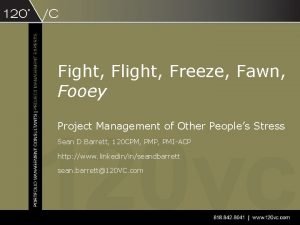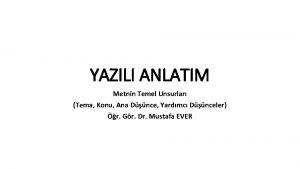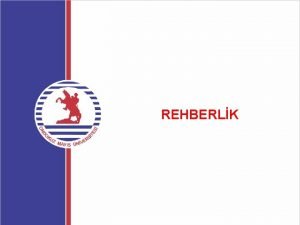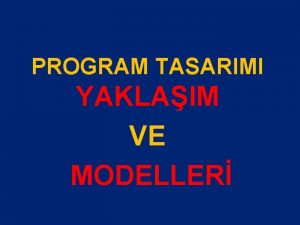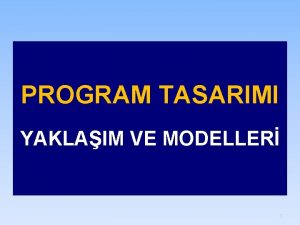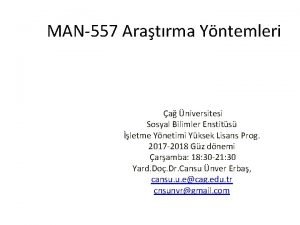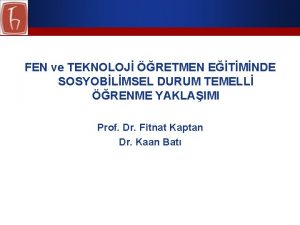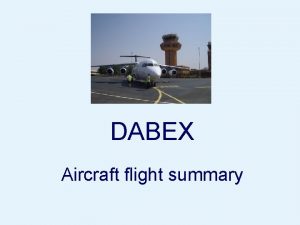NANTAI NVERSTES FLIGHT THEORY KONU 2 THEAIRPLANE NANTAI









- Slides: 9

NİŞANTAŞI ÜNİVERSİTESİ FLIGHT THEORY KONU: 2. THEAIRPLANE NİŞANTAŞI ÜNİVERS İTESİ ©

2. 2. Engine Airplanes can be powered by a variety of engines, and the two fundamental types are reciprocating or piston engines and gas turbines (jets). The jet engine will not be considered in this manual. The piston engine can be designed in various ways, many of which are suitable for airplanes. Older engine types often had the cylinders arranged radially around the crankshaft, for example the radial powerplants in the Stearman, Douglas DC-3, North American T-6, de Havilland Canada Beaver and Cessna 195. The de Havilland Canada Beaver and the Grumman Ag-Cat are two types with radial engines that are still in use today. These engines have an excellent power/weight ratio in the high power range required for operations such as agricultural spraying. NİŞANTAŞI ÜNİVERSİTESİ ©

Some airplanes have in-line engines, where the cylinders are arranged in one line — the same basic design as in many automobiles. Some of the earliest airplanes had upright, in-line engines, with the cylinder head at the top of the engine and the crankshaft/propeller shaft at the bottom, but this caused some design problems. Raising the thrust line to a suitable position, put the cylinders and the main body of the engine in a very high position. This obscured the pilot’s vision and prevented effective streamlining. Another problem was the ground clearance of the propeller, requiring long struts for the mainwheels. The easiest way to solve this problem was to invert the engine and have the crankshaft/propeller shaft at the top of the engine. Many airplanes have these inverted in-line engines. There are other possibilities, such as V-engines and H-engines (V and H describes the layout of the cylinders). NİŞANTAŞI ÜNİVERSİTESİ ©

Exhaust System The burnt gases leave the engine cylinders and are carried out to the atmosphere via the exhaust system. It is important that there is no leakage of exhaust gas into the cabin because it contains carbon monoxide, a colorless and odorless gas that is difficult to detect, but can cause loss of consciousness and death. NİŞANTAŞI ÜNİVERSİTESİ ©

The Oil System The purpose of the oil system is to circulate oil around the engine, to: • lubricate the moving parts so that they can move smoothly; • prevent high temperatures by reducing friction between the moving parts; • provide a seal between the cylinder walls and the pistons, increasing the effectiveness of the expanding gases in the combustion process; • assist in cooling the engine by carrying some of the heat generated by combustion away from the pistons; and • carry away contaminants which are then removed in an oil filter. Sufficient quantity of oil of the correct grade is absolutely essential. An oil dipstick to check oil quantity is generally found under a small cowl above the engine, along with an oil filling point if more oil is required. Always check that the oil filler cap has been firmly replaced prior to flight. Indication of correct operation of the oil system is provided in the cockpit by an oil pressure gauge, an oil temperature gauge, and, in some aircraft, a cylinder-head temperature gauge. NİŞANTAŞI ÜNİVERSİTESİ ©

The Cooling System The engine cooling system is designed to keep the engine temperatures within those limits designed by the manufacturer. The burning of the fuel/air mixture in the engine’s cylinders, and the friction of its moving parts, results in the engine heating up. Engine temperatures are kept within acceptable limits by: • the oil that circulates within the engine; • expulsion of much heat energy in the exhaust gases; and • the air cooling system that circulates fresh air around the engine compartment NİŞANTAŞI ÜNİVERSİTESİ ©

Accelerator Pump When you fully open the throttle, the butterfly valve is fully opened and does not restrict the airflow through the venturi. The airflow therefore increases. If the throttle is opened quickly, the airflow initially increases at a rate greater than the fuel flow, producing an insufficient lean mixture. This would cause a lag in the production of power if it were not for the accelerator pump. The accelerator pump is therefore used to prevent a weak-cut when the throttle is rapidly opened. The accelerator pump is a small plunger within the float chamber, connected to the throttle linkage so that it gives an extra spurt of fuel as the throttle is opened. Idling System When the engine is idling with the butterfly valve almost closed, the pressure differential between the venturi and the float chamber is not great enough to force fuel through the main jet. To allow for this, there is a small idling jet with an inlet near the butterfly valve, where a small venturi effect is caused when the valve is almost closed. This provides sufficient fuel to mix with the air to keep the engine idling at low RPM. NİŞANTAŞI ÜNİVERSİTESİ ©

Fuel/Air Mixture Control The fuel/air ratio is the ratio between the weight of fuel and the weight of air mixed together and entering the cylinders where the combustion process is to occur. The carburetor is the device used to mix the fuel and the air, and it is designed in its most basic form to function best under mean sea level conditions at standard temperature +15°C (59°F). Under other conditions when the air density is significantly less, such as at high altitudes or with high temperatures, the basic operation of the carburetor must be modified by the pilot to maintain a suitable fuel/air ratio. NİŞANTAŞI ÜNİVERSİTESİ ©

Fuel Injection Systems Many sophisticated engines have fuel directly metered into the induction manifold and then into the cylinders without using a carburetor. This is known as fuel injection. A venturi system is still used to create the pressure differential. This is coupled to a fuel control unit (FCU), from which metered fuel is piped to the fuel manifold unit (fuel distributor). From here, a separate fuel line carries fuel to the discharge nozzle in each cylinder head, or into the inlet port prior to the inlet valve. The mixture control in the fuel injection system controls the idle cut-off. With fuel injection, each individual cylinder is provided with a correct mixture by its own separate fuel line. (This is unlike the carburetor system, which supplies the same fuel/air mixture to all cylinders. This requires a slightly richer-than-ideal mixture to ensure that the leanest-running cylinder does not run too lean. ) The advantages of fuel injection include: • freedom from fuel ice (no suitable place for it to form); • more uniform delivery of the fuel/air mixture to each cylinder; • improved control of fuel/air ratio; • fewer maintenance problems; • instant acceleration of the engine after idling with no tendency for it to stall; and • increased engine efficiency. NİŞANTAŞI ÜNİVERSİTESİ ©


